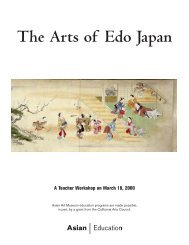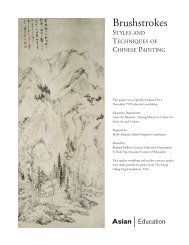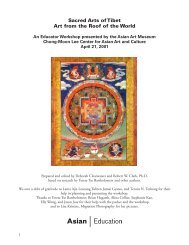China:The Glorious Tang And Song Dynasties - Asian Art Museum ...
China:The Glorious Tang And Song Dynasties - Asian Art Museum ...
China:The Glorious Tang And Song Dynasties - Asian Art Museum ...
You also want an ePaper? Increase the reach of your titles
YUMPU automatically turns print PDFs into web optimized ePapers that Google loves.
<strong>The</strong> poem describes the performance of a dancing girl from Sogdiana, which was a state in<br />
Central Asia. <strong>The</strong> poet is impressed by the dynamic movements of the girl, who spins according to<br />
the rhythm of drum sound. <strong>The</strong> poet enjoys her excellent performance and greatly praises her dancing<br />
skills. However, the poet also laments, perhaps with compassion or simply with native pride,<br />
that the girl is not in the right place to sell her skill because the dance is already so familiar to the<br />
Chinese. In his opinion, many Chinese dancers could dance just as well as, if not better than, the<br />
Sogdiana girl!<br />
3. SONG POETRY<br />
<strong>The</strong> achievements of <strong>Song</strong> poetry were as great as those of <strong>Tang</strong>. <strong>The</strong> <strong>Song</strong> dynasty actually produced<br />
more poets and more poems than the <strong>Tang</strong> because of the general expansion of literacy at<br />
that time. <strong>Song</strong> poets admired the excellence of <strong>Tang</strong> poetry, while at the same time <strong>Song</strong> poets<br />
explored directions which were ignored by their <strong>Tang</strong> predecessors. In contrast to the <strong>Tang</strong>, <strong>Song</strong><br />
poets narrated more details of their daily lives, exhibited a deeper sense of social and political<br />
involvement, and enthusiastically discussed philosophy in their poems.<br />
<strong>The</strong> concerns of daily life: “Children” by Su Shi<br />
Unlike <strong>Tang</strong> society, the <strong>Song</strong> people lived under a weak dynasty whose borders were threatened,<br />
and political life was full of partisan strife. Consequently, society adopted a more defensive outlook<br />
regarding foreign ideas and frontiers, turning inward and taking a more cautious approach to unbridled<br />
emotion. Reflecting this inclination, <strong>Song</strong> poets were fond of observing their environment no<br />
matter how trivial and routine it might appear. <strong>The</strong>y consciously examined their daily lives and they<br />
believed that routine details deserved to be noticed. <strong>Song</strong> poets sincerely embraced many mundane<br />
matters as appropriate themes in poetry, expressing feelings closer to home than those of the <strong>Tang</strong><br />
poets. A good example is the poem “Children” of Su Shi.<br />
Su Shi (1037–1101; also known by literary name Su Dongpo) is considered by many to be the<br />
greatest of the <strong>Song</strong> poets. He was born in a famous literati family at Meishan, Sichuan. Like most<br />
other <strong>Song</strong> elites, he passed the civil service exam and started a career in politics. However, his<br />
major achievements were in liberal arts. He established himself as a painter, calligrapher, essayist,<br />
and above all a poet. In total, he wrote about 2,700 poems. Like his <strong>Tang</strong> predecessor Li Bo, he was<br />
a person endowed with an innate freedom of spirit; he was also fond of wine, though he was not as<br />
prolific as his <strong>Tang</strong> predecessor in its consumption. He was also very interested in Chan (later<br />
known in Japan as Zen) meditation. However, the following poem shows that even though Su Shi<br />
was spiritual, free person, he also was attentive to daily life.<br />
21
















